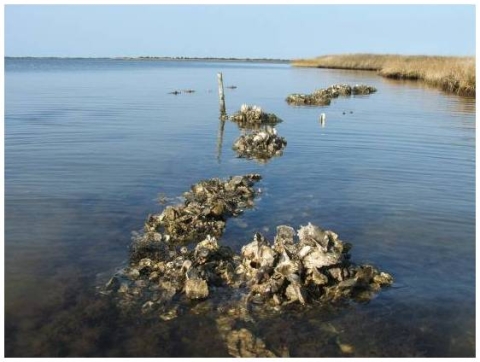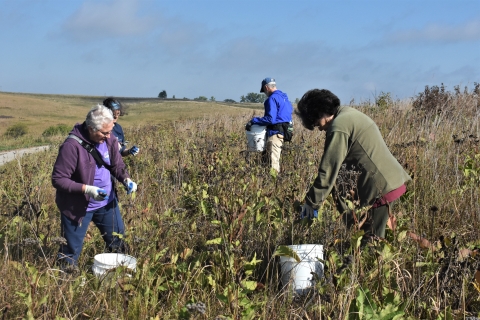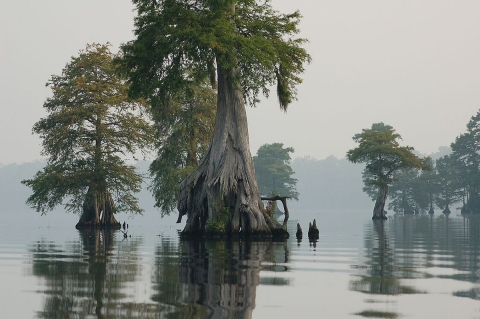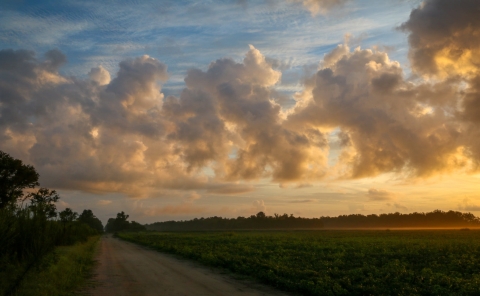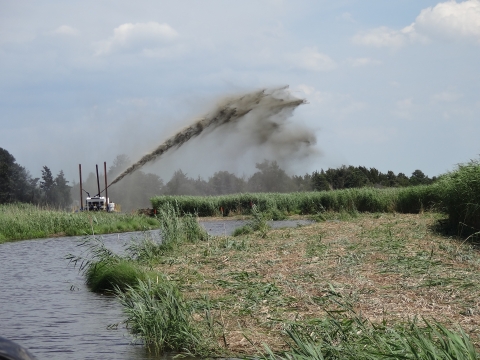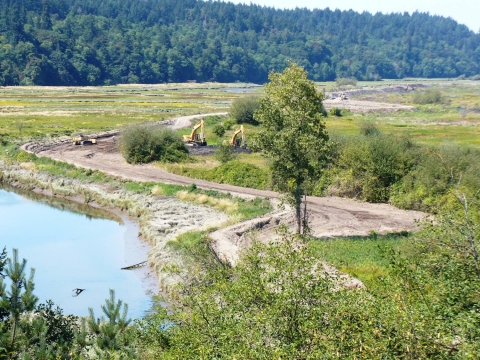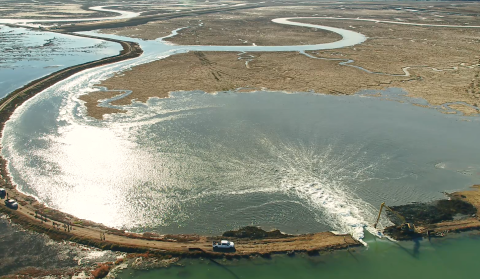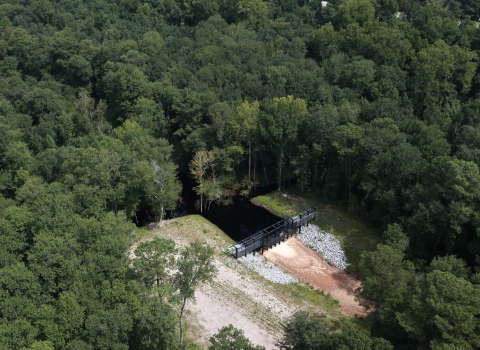When the U.S. Fish and Wildlife Service uses nature-friendly techniques to make its managed lands more resistant to floods, wildfire, drought and invasive species invasive species
An invasive species is any plant or animal that has spread or been introduced into a new area where they are, or could, cause harm to the environment, economy, or human, animal, or plant health. Their unwelcome presence can destroy ecosystems and cost millions of dollars.
Learn more about invasive species , it improves wildlife habitat.
But that's not all. As these techniques enhance conditions on national wildlife refuges, nearby human communities realize related gains in water quality, recreation opportunities and overall human health.
The Service is a longtime leader in using nature-based solutions to meet environmental challenges and conserve America’s wildlife. Wildlife conservation relies on restoring wetlands, forests, prairies and other ecosystems.
Nature-based solutions are sustainable practices that use environmentally friendly features or processes to make landscapes more resilient to changes in climate and other conditions.
Nature-Friendly Remedies
Climate change threatens ecosystems worldwide. Rising seas are eroding coastal habitats. Invasive species are proliferating. Wildfires and floods are intensifying. And biodiversity is suffering.
To meet this urgent problem with limited resources, the Fish and Wildlife Service prioritizes nature-friendly solutions that benefit both wildlife conservation and human communities.
Some examples of nature-based solutions include:
- Returning natural water flow to drained wetlands and dammed rivers and streams
- Using natural materials to create living shorelines as erosion buffers
Sequestering carbon in peat marshes, forests and prairie to prevent carbon dioxide release
- Thinning forests and conducting prescribed fires to reduce wildfire risk.
The photo at the top of the page shows an aerial view of one nature-based solution: a living shoreline at Martin National Wildlife Refuge, on the northern half of Smith Island in Maryland. The Service used oyster reefs to stabilize 20,950 feet of shoreline, protecting more than 1,200 acres of tidal marsh, submerged aquatic vegetation and clam beds against storms.These saltwater habitats support the island's soft crab fishery, a natural resource local Smith Island residents depend on for their livelihoods.
Hidden Carbon Capture Potential
- 200,000 — Metric tons of carbon sequestered each year by restored peat wetlands at Great Dismal Swamp National Wildlife Refuge, enough to offset annual emissions of 42,000 vehicles
760+ M — Marine acres cooperatively managed by the Service that store “blue carbon” that would otherwise go into the atmosphere. Blue carbon is found in marine coastal ecosystems such as mangroves, salt marshes, and seagrass meadows.
- $976 M — Damage avoided to agriculture, health and property each year by conserving carbon-rich peat wetlands on wildlife refuges
Re-Wetting Peat Swamps
North Carolina’s Albemarle-Pamlico Peninsula offers a flagship example of the climate adaptation, resilience and mitigation benefits of nature-based solutions.
Pocosin Lakes National Wildlife Refuge is one of nine national wildlife refuges that share the peninsula and its estuaries, which support the region’s fishing and tourism industries. Sea-level rise, storm flooding and wildfires are perennial threats.
With federal funding from the Inflation Reduction Act, the Fish and Wildlife Service and its partners have restored 37,000 acres of peatland at Pocosin Lakes Refuge. Restoring the natural hydrology of peat soils improves wildlife habitat while lowering the risk of stormwater flooding, wildfire and sea-level rise to nearby coastal communities. Carbon storage also goes up.
The carbon stored in Refuge System grasslands, forests, wetlands accounts for $976 million a year in avoided damage.to agriculture, human health and property, according to a 2022 study in the scientific journal PLOS.
At Great Dismal Swamp National Wildlife Refuge — also part of the Albemarle-Pamlico project — the Service has installed 46 water control structures in 150 miles of old drainage ditches over the past decade. Hydrologists are using the structures to "re-wet" the swamp, retain carbon-rich peat soil and lower the risk of catastrophic wildfire. The refuge’s restored peat wetlands sequester 200,000 metric tons of carbon per year, offsetting the annual emissions of 42,000 vehicles, found a U.S. Geological Survey/U.S. Fish and Wildlife Service study.
Restoring Coasts and Prairies
At Prime Hook National Wildlife Refuge on the Delaware coast, a $38 million marsh restoration completed in 2016 has boosted storm and tide resilience. It has also increased nesting habitat for horseshoe crabs and least terns and attracted piping plovers to nest for the first time.
In the Midwest, restoring native prairie conserves wildlife habitat and fosters carbon storage. The roots of prairie plants store carbon below ground, in amounts that can exceed those of forests above ground. At Neal Smith National Wildlife Refuge in Iowa, the Service has restored cropped land to native prairie since 1992. Researchers who sampled soil at 19 restored prairie tracts found that older prairies stored more biologically active carbon in near-surface soil than younger prairies. But total carbon storage at any depth showed greater age variability.
Reviving Forests
In the Lower Mississippi River Valley — covering parts of Arkansas, Louisiana, Mississippi and Tennessee — $20 million worth of nature-based resiliency projects also promise climate benefits. For decades, the land was cleared for agriculture. Now, less than a quarter of the region’s original 25 million acres of bottomland hardwood forest remain. The Service and partners are restoring forest at dozens of sites such as Tensas River National Wildlife Refugein Louisiana. where 11,000 reforested acres are projected to store 360 metric tons of carbon from the atmosphere. These restored forests act as a natural carbon sink while also providing important wildlife habitat.
Showing the Way
To broaden the use of nature-based solutions, the Fish and Wildlife Service partners with states, Tribes, local governments and private landowners to identify and carry out high-return NbS investments. These projects offer societal as well as environmental benefits.
- Community-Centered Conservation: The Service partners with communities to ensure projects meet local needs and are sustainable. Since 1996, for example, the Nisqually Tribe and the Service have jointly restored more than 900 acres of wetlands in the Pacific Northwest, boosting fish populations important to the Tribe.
- Leveraged Funds: The Service stretches budgeted dollars by leveraging funds available through legislation such as the Bipartisan Infrastructure Law Bipartisan Infrastructure Law
The Bipartisan Infrastructure Law (BIL) is a once-in-a-generation investment in the nation’s infrastructure and economic competitiveness. We were directly appropriated $455 million over five years in BIL funds for programs related to the President’s America the Beautiful initiative.
Learn more about Bipartisan Infrastructure Law (BIL) and the Inflation Reduction Act (IRA). For example, the Service allocated nearly $90 million from BIL to help restore ecosystems in the drought-stricken Klamath Basin over the next five years. The effort stands to benefit both Oregon and northern California. - Biodiversity: The National Wildlife Refuge System is a critical reservoir of biodiversity, with 351 out of 571 refuges dedicated to recovering threatened and endangered species, such as the black-footed ferret, California condor, and green sea turtle. Recovering species helps safeguard the intricate web of life that underpins climate resilience. While the relationship between biodiversity and ecosystem stability is complex and variable, studies show the two are positively linked.
- Carbon Capture: Many NbS projects offer an opportunity to sequester carbon and slow its release into the atmosphere. Slowing the rate of carbon emissions is critical to fighting climate change climate change
Climate change includes both global warming driven by human-induced emissions of greenhouse gases and the resulting large-scale shifts in weather patterns. Though there have been previous periods of climatic change, since the mid-20th century humans have had an unprecedented impact on Earth's climate system and caused change on a global scale.
Learn more about climate change . At Tensas River National Wildlife Refuge in Louisiana, 11,000 acres of forest being restored by the Service and partners are projected to store 360 metric tons of carbon. - America the Beautiful: Nature-based solutions are key to achieving the goals of the America the Beautiful initiative, which aims to conserve, connect, and restore 30% of the nation's lands and waters by 2030. Since January 2021, the Fish and Wildlife Service has added roughly 500,000 acres to the National Wildlife Refuge System.
- Blue carbon: Protecting and restoring coastal and ocean habitats helps combat climate change because these ecosystems capture and store carbon.
Restoring the South Bay
In San Francisco Bay, the Fish and Wildlife Service and partners are engaged in the West Coast’s largest tidal wetland restoration. The South Bay Salt Pond Restoration Project aims to restore 15,000 acres of lost tidal marshby 2050, improving conditions for wildlife and people.
So far, tidal flow has been returned to more than 3,000 acres that former owners drained for use in industrial salt production. Some of those acres are at Don Edwards San Francisco Bay National Wildlife Refuge, a natural gem in the highly urban Bay area. Benefits so far include improved habitat for some waterbirds and endangered species like the Ridgway’s rail, reduced flood risk and improved public recreation access.
The restoration is badly needed. A century and a half of urban development, pollution and habitat destruction has depleted bay habitat and destroyed natural storm buffers.
Now, climate change is adding to problems, fueling storms that release millions of gallons of wastewater into city streets and into the bay. Project partners hope restored marshes will improve the picture.

